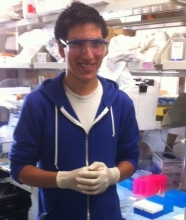
Major:
Mentor(s):
Faculty Sponsor(s):
Faculty Sponsor's Department(s):
Project Title:
Project Description:
Nucleic acids, such as DNA and RNA, are pertinent to applied science at the nanoscale because of their tertiary structures. RNA tertiary structure, when compared to DNA, is considered more dynamic in nature because it can fold into multiple structural motifs, such as tetraloops and receptors. The objective was to analyze evolutionary pathways between receptors selected in vitro and the naturally occurring 11-nucleotide receptor to provide insight on how evolutionary changes might have occurred. For this study, we organized functional receptors, for GNRA tetraloop sequences—where N is any nucleotide, and R is any purine, into a network linked through mutated intermediates. We were interested in determining how designable these tertiary interactions were, and whether or not the naturally occurring 11-nucleotide motif was a result of evolutionary convergence. The principle methods used involved DNA amplification, transcription and radiolabeling to provide the RNA samples, and polyacrylamide gel electrophoresis (PAGE) to test them. The analysis of these PAGE gels provided qualitative and quantitative data for receptor interactions with different GNRA tetraloops. Analysis of these results revealed that these RNA tertiary interactions have a high degree of plasticity, which led to the characterization of intermediates between receptors with varying specificity. The susceptibility to mutation and multiple proposed evolutionary pathways suggest that convergence is a likely reason for the prevalence of the 11-nucleotide motif in nature. Furthermore, the establishment of this receptor network provides groundwork for potential developments in nanoconstruction, as the receptors have been characterized and compiled into a library of functional sequences.
